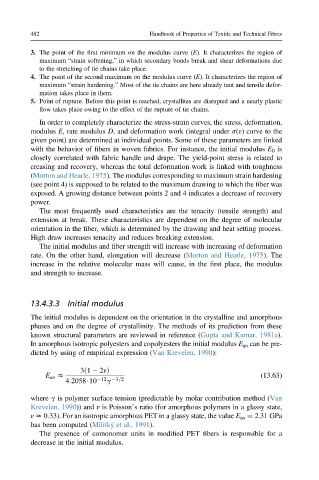Page 509 - Handbook of Properties of Textile and Technical Fibres
P. 509
482 Handbook of Properties of Textile and Technical Fibres
3. The point of the first minimum on the modulus curve (E). It characterizes the region of
maximum “strain softening,” in which secondary bonds break and shear deformations due
to the stretching of tie chains take place.
4. The point of the second maximum on the modulus curve (E). It characterizes the region of
maximum “strain hardening.” Most of the tie chains are here already taut and tensile defor-
mation takes place in them.
5. Point of rupture. Before this point is reached, crystallites are disrupted and a nearly plastic
flow takes place owing to the effect of the rupture of tie chains.
In order to completely characterize the stress-strain curves, the stress, deformation,
modulus E, rate modulus D, and deformation work (integral under s(ε) curve to the
given point) are determined at individual points. Some of these parameters are linked
with the behavior of fibers in woven fabrics. For instance, the initial modulus E 0 is
closely correlated with fabric handle and drape. The yield-point stress is related to
creasing and recovery, whereas the total deformation work is linked with toughness
(Morton and Hearle, 1975). The modulus corresponding to maximum strain hardening
(see point 4) is supposed to be related to the maximum drawing to which the fiber was
exposed. A growing distance between points 2 and 4 indicates a decrease of recovery
power.
The most frequently used characteristics are the tenacity (tensile strength) and
extension at break. These characteristics are dependent on the degree of molecular
orientation in the fiber, which is determined by the drawing and heat setting process.
High draw increases tenacity and reduces breaking extension.
The initial modulus and fiber strength will increase with increasing of deformation
rate. On the other hand, elongation will decrease (Morton and Hearle, 1975). The
increase in the relative molecular mass will cause, in the first place, the modulus
and strength to increase.
13.4.3.3 Initial modulus
The initial modulus is dependent on the orientation in the crystalline and amorphous
phases and on the degree of crystallinity. The methods of its prediction from these
known structural parameters are reviewed in reference (Gupta and Kumar, 1981a).
In amorphous isotropic polyesters and copolyesters the initial modulus E ao can be pre-
dicted by using of empirical expression (Van Krevelen, 1990):
E ao z 3ð1 2nÞ (13.63)
g
4:2058$10 12 3=2
where g is polymer surface tension (predictable by molar contribution method (Van
Krevelen, 1990)) and n is Poisson’s ratio (for amorphous polymers in a glassy state,
n z 0:33). For an isotropic amorphous PET in a glassy state, the value E ao ¼ 2.31 GPa
has been computed (Militký et al., 1991).
The presence of comonomer units in modified PET fibers is responsible for a
decrease in the initial modulus.

